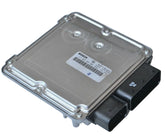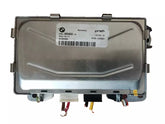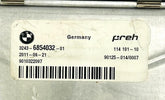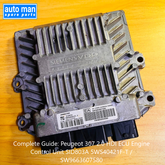How to Identify and Replace a Faulty A034X847 NOx Sensor 5WK96675A: Complete Guide for Diesel Vehicle Owners
Complete Guide: How to Know if Your NOx Sensor Is Damaged, How to Replace It, and How to Prevent Failure
If you drive a modern diesel vehicle, especially one from brands like BMW, Mercedes-Benz, Audi, or any Cummins-powered truck, the NOx sensor (Nitrogen Oxide Sensor) plays a critical role in managing emissions. Over time, however, these sensors can fail, causing performance issues, warning lights, and even failed emissions tests.
In this comprehensive guide from Automan Spare Parts, we'll walk you through:
-
How to identify a faulty NOx sensor
-
How to replace it step by step
-
Tips to protect your NOx sensor from future damage
What is a NOx Sensor?
A NOx sensor is part of your vehicle’s SCR (Selective Catalytic Reduction) system. It monitors nitrogen oxide levels in the exhaust gases and helps regulate the injection of Diesel Exhaust Fluid (DEF) to reduce harmful emissions. Vehicles with Euro 5/6 or EPA standards use one or two NOx sensors (upstream and downstream).
Signs of a Damaged NOx Sensor
Here’s how you can tell if your NOx sensor may be failing:
1. Check Engine Light (CEL) or Emission Warning Light
A faulty NOx sensor will often trigger a warning light on the dashboard.
2. Loss of Power or Poor Acceleration
When the sensor provides incorrect data, the ECU may restrict power to reduce emissions.
3. High Fuel Consumption
Incorrect NOx readings can cause the engine to run rich, leading to more fuel use.
4. Poor DEF System Performance
You may see DEF warnings or experience issues with the AdBlue system.
5. Emission Test Failure
Excess NOx output due to a bad sensor can lead to immediate test failure.
6. Diagnostic Trouble Codes (DTCs)
Using an OBD-II scanner, you may find codes like:
-
P2200 to P229F
-
Sensor heater circuit malfunction
-
NOx signal range/performance issues
Step-by-Step: How to Replace a NOx Sensor
Tools Required:
-
Vehicle jack or lift
-
Oxygen sensor socket
-
Ratchet and extension
-
Torque wrench
-
OBD-II scanner (optional)
Time Required: 30 to 60 minutes
Step 1: Locate the Sensor
Most vehicles have:
-
Upstream Sensor: Near the turbocharger or exhaust manifold
-
Downstream Sensor: After the SCR catalyst
Refer to your service manual or contact us for help with sensor location based on your VIN.
Step 2: Disconnect the Battery
Always disconnect the vehicle battery to avoid triggering fault codes or damaging the ECU.
Step 3: Remove the Old NOx Sensor
-
Disconnect the sensor’s electrical connector
-
Use an oxygen sensor socket to unscrew the sensor from the exhaust
-
Be careful—sensors can get extremely hot. Make sure the exhaust is cool.
Step 4: Install the New Sensor
-
Thread in the new sensor carefully by hand
-
Tighten with the socket and torque wrench to manufacturer’s specs
-
Reconnect the electrical plug securely
Step 5: Clear Fault Codes (Optional but Recommended)
Use an OBD-II scanner to clear any stored trouble codes. Some vehicles will reset automatically after a few driving cycles.
How to Prevent NOx Sensor Damage
1. Use High-Quality Diesel Fuel
Poor fuel quality can cause soot buildup and clog the sensor.
2. Regularly Drive at Highway Speeds
Short city trips don’t allow the exhaust system to heat up properly. A regular highway drive helps burn off carbon buildup.
3. Refill DEF/AdBlue on Time
Running low or out of DEF can force the system into limp mode, overloading the sensor.
4. Avoid Oil Leaks into Exhaust
Leaking valve seals or turbo seals can coat the sensor in oil, damaging it quickly.
5. Perform Regular DPF Regeneration
A clogged DPF can cause backpressure and increase exhaust heat, damaging sensors.
Shop Genuine NOx Sensors at Automan Spare Parts
At Automan Spare Parts, we stock original and high-quality aftermarket NOx sensors for:
-
BMW, Mercedes-Benz, Audi, Cummins, VW, and more
-
Guaranteed fitment using your VIN
-
Worldwide shipping
-
Competitive wholesale pricing
Final Thoughts
A damaged NOx sensor doesn’t just affect emissions—it can hurt your engine’s performance, fuel economy, and cause expensive repairs. Knowing the symptoms, replacing it early, and taking preventive measures can save you time and money.
Need help choosing the right NOx sensor for your car or truck?
📩 Contact our expert support team today or browse our full NOx sensor collection on www.automanspareparts.com.







